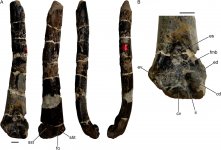albertonykus
Well-known member
Degrange, F.J. (2022)
A new species of Dryornis (Aves, Cathartiformes) from the Santa Cruz Formation (lower Miocene), Patagonia, Argentina
Journal of Vertebrate Paleontology (advance online publication)
doi: 10.1080/02724634.2021.2008411
No abstract, first paragraph of the introduction is copied below:
The Santa Cruz Formation (lower Miocene) has one of the richest fossil assemblages in South America (Vizcaíno et al., 2012). Fossils were first collected in the 19th century, when the expeditions carried out by Francisco P. Moreno and Carlos Ameghino resulted in the discovery of different species, mainly mammals. This Cenozoic fauna caught the attention of William B. Scott of Princeton University (U.S.A.) who trusted John B. Hatcher to lead the expeditions to Patagonia between 1896 and 1899. Hatcher visited different localities in the Santa Cruz province, mainly on the Atlantic coast, spending less time in the outcrops along the Santa Cruz River and in the Andean region (Fernícola et al., 2019). After collecting a large amount of specimens, he returned to the U.S.A., where the material was deposited in the paleontological collections of the Peabody Museum (New Haven) and the American Museum of Natural History (New York). Taking into account that some of the materials were fragmentary or poorly visited and consulted, the phylogenetic affinities of some of the remains are still a subject of debate.
A new species of Dryornis (Aves, Cathartiformes) from the Santa Cruz Formation (lower Miocene), Patagonia, Argentina
Journal of Vertebrate Paleontology (advance online publication)
doi: 10.1080/02724634.2021.2008411
No abstract, first paragraph of the introduction is copied below:
The Santa Cruz Formation (lower Miocene) has one of the richest fossil assemblages in South America (Vizcaíno et al., 2012). Fossils were first collected in the 19th century, when the expeditions carried out by Francisco P. Moreno and Carlos Ameghino resulted in the discovery of different species, mainly mammals. This Cenozoic fauna caught the attention of William B. Scott of Princeton University (U.S.A.) who trusted John B. Hatcher to lead the expeditions to Patagonia between 1896 and 1899. Hatcher visited different localities in the Santa Cruz province, mainly on the Atlantic coast, spending less time in the outcrops along the Santa Cruz River and in the Andean region (Fernícola et al., 2019). After collecting a large amount of specimens, he returned to the U.S.A., where the material was deposited in the paleontological collections of the Peabody Museum (New Haven) and the American Museum of Natural History (New York). Taking into account that some of the materials were fragmentary or poorly visited and consulted, the phylogenetic affinities of some of the remains are still a subject of debate.





